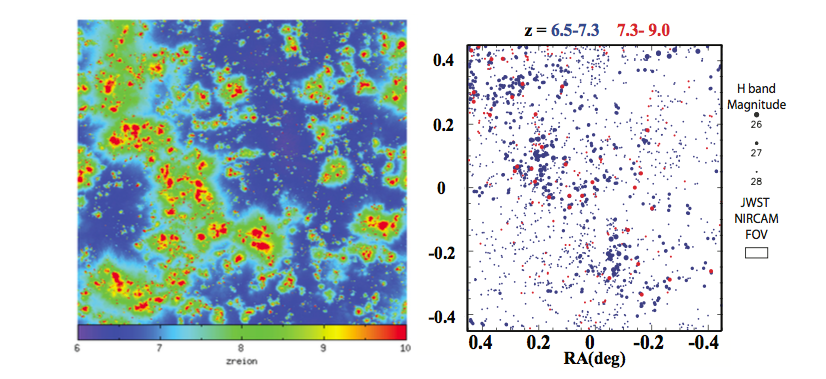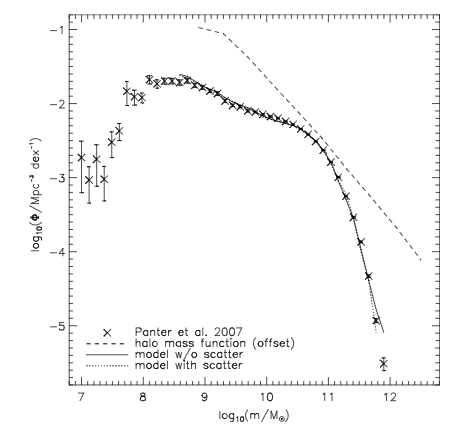So, what is the origin of cosmic structures? In particular, the walls, sheets and filaments composed of galaxies and galaxy clusters? Although the seeding of these structures by tiny fluctuations in the cosmic microwave background remains our dominant paradigm for galaxy formation, there are still — of course — unanswered questions. In particular, what role does “dark matter” play in galaxy formation and the regulation of star formation?
Today, ever-deeper “pencil-beam” surveys (like CANDELS) have continued to probe further and further back in cosmic time. We are now tantalizingly close to observing the epoch of galaxy formation, a few hundred million years after the big bang. However, to make stringent and robust comparisons to models, all current surveys are all too small: even the COSMOS field (Scoville et al. 2007), spanning two square degrees, is unable to probe scales sufficiently large to see the surface of the giant “bubbles” where the first galaxies form. These surveys contain relatively few massive objects, meaning that the number of massive objects for spectroscopic follow up is small. It is clear that new surveys are needed.

Figure 1. A re-ionisation simulation from Trac et al. showing a 1 deg^2 patch of sky. The right panel shows the galaxies, with the equivalent JWST field of view. Finding these faint objects directly with a blind JWST survey would be impossible.
The Euclid satellite mission will precisely measure the cosmological equation of state by combining two independent probes of the accelerating Universe: weak gravitational lensing and galaxy clustering. However, the precision of the Euclid cosmological figure-of-merit is completely dominated by systematic errors in both shape measurement and photometric redshift determination. For this reason, the Euclid surveys are divided into a 15,000deg2 “wide” component and a much deeper survey covering tens of square degrees. The deep survey allows one make measurements at a much better signal-to-noise for a smaller sub-area of the total survey in order to understand measurement biases. Euclid provides ultra-deep visible and near-infrared imaging, but no multi-colour data or infrared data. Therefore, a major campaign is now underway to collect the ancillary data essential for the success of the mission. In addition to solving the problems of systematic errors in cosmological parameter estimation, these deep fields will provide the key to unlock the puzzle of structure and galaxy formation at intermediate to high redshifts.. This thesis uses the Spitzer Legacy Survey (SLS) data currently being carried out on the Euclid deep survey fields. The SLS project is led by Peter Capak at the Spitzer Science Center .

Candidate high-redshift clusters selected in the SSDF. For more information, see Rettura et al. (2014).
The SLS represents the largest allocation of Spitzer time ever made (~5300hrs); observations started in 2016. Using Spitzer’s IRAC camera the survey will reach AB~25 in CH1 over 20 deg2, with an exposure time of around 2hrs per pixel. This data is crucial to find high redshift objects and also to make samples cleanly selected by stellar mass (Laigle et al. 2016). Using this data, we will be able to assemble a unique sample of high-redshift galaxy clusters using a well-tested colour-colour selection criteria. Because this sample is large and coversa large contiguous field we will also be able to measure the clustering properties of the selected objects. Clustering is essential to understand what the relationship is between dark matter and luminous matter. It has been known for a while now that galaxy formation is inefficient: Figure 3. shows a comparison between the number of dark matter haloes and the number of galaxies. They are very different–why is that? What stops galaxies forming in massive and low-mass haloes?

Figure 3. From Moster et al, the comparison between the halo mass function and stellar mass function. Why is the number of dark matter haloes very different from the number of galaxies?
The thesis will be supervised at the Institut d’Astrophysique de Paris by http://www2.iap.fr/users/hjmcc/ and co-supervised by Herve Dole at IAS, Orsay. Travel funds and computing resources will be made available to the successful applicant. A funding proposal for this thesis has been made to The DIM-ACAV. This project will take place in the framework of the CALET project.
The standardized page for this project in in ADUM can be found here. If you are interested, contact us!